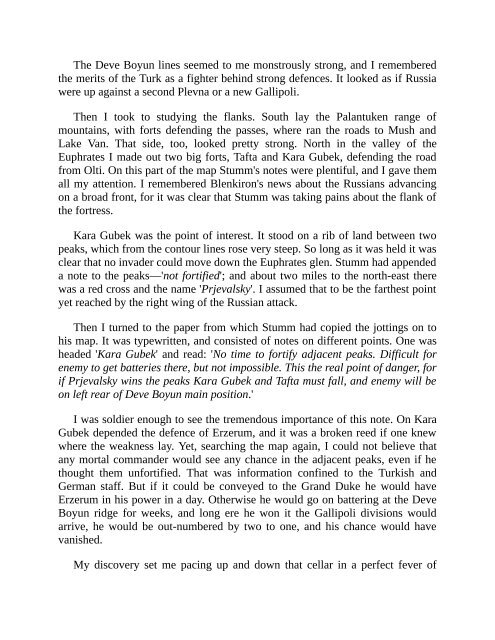Greenmantle - John Buchan
Greenmantle es la segunda de las cinco novelas de John Buchan con el personaje de Richard Hannay , publicado por primera vez en 1916 por Hodder & Stoughton , Londres . Es una de las dos novelas de Hannay ambientadas durante la Primera Guerra Mundial , la otra es el Sr. Standfast (1919); La primera y más conocida aventura de Hannay, The Thirty-Nine Steps (1915), se desarrolla en el período inmediatamente anterior a la guerra.
Greenmantle es la segunda de las cinco novelas de John Buchan con el personaje de Richard Hannay , publicado por primera vez en 1916 por Hodder & Stoughton , Londres . Es una de las dos novelas de Hannay ambientadas durante la Primera Guerra Mundial , la otra es el Sr. Standfast (1919); La primera y más conocida aventura de Hannay, The Thirty-Nine Steps (1915), se desarrolla en el período inmediatamente anterior a la guerra.
You also want an ePaper? Increase the reach of your titles
YUMPU automatically turns print PDFs into web optimized ePapers that Google loves.
The Deve Boyun lines seemed to me monstrously strong, and I remembered<br />
the merits of the Turk as a fighter behind strong defences. It looked as if Russia<br />
were up against a second Plevna or a new Gallipoli.<br />
Then I took to studying the flanks. South lay the Palantuken range of<br />
mountains, with forts defending the passes, where ran the roads to Mush and<br />
Lake Van. That side, too, looked pretty strong. North in the valley of the<br />
Euphrates I made out two big forts, Tafta and Kara Gubek, defending the road<br />
from Olti. On this part of the map Stumm's notes were plentiful, and I gave them<br />
all my attention. I remembered Blenkiron's news about the Russians advancing<br />
on a broad front, for it was clear that Stumm was taking pains about the flank of<br />
the fortress.<br />
Kara Gubek was the point of interest. It stood on a rib of land between two<br />
peaks, which from the contour lines rose very steep. So long as it was held it was<br />
clear that no invader could move down the Euphrates glen. Stumm had appended<br />
a note to the peaks—'not fortified'; and about two miles to the north-east there<br />
was a red cross and the name 'Prjevalsky'. I assumed that to be the farthest point<br />
yet reached by the right wing of the Russian attack.<br />
Then I turned to the paper from which Stumm had copied the jottings on to<br />
his map. It was typewritten, and consisted of notes on different points. One was<br />
headed 'Kara Gubek' and read: 'No time to fortify adjacent peaks. Difficult for<br />
enemy to get batteries there, but not impossible. This the real point of danger, for<br />
if Prjevalsky wins the peaks Kara Gubek and Tafta must fall, and enemy will be<br />
on left rear of Deve Boyun main position.'<br />
I was soldier enough to see the tremendous importance of this note. On Kara<br />
Gubek depended the defence of Erzerum, and it was a broken reed if one knew<br />
where the weakness lay. Yet, searching the map again, I could not believe that<br />
any mortal commander would see any chance in the adjacent peaks, even if he<br />
thought them unfortified. That was information confined to the Turkish and<br />
German staff. But if it could be conveyed to the Grand Duke he would have<br />
Erzerum in his power in a day. Otherwise he would go on battering at the Deve<br />
Boyun ridge for weeks, and long ere he won it the Gallipoli divisions would<br />
arrive, he would be out-numbered by two to one, and his chance would have<br />
vanished.<br />
My discovery set me pacing up and down that cellar in a perfect fever of














